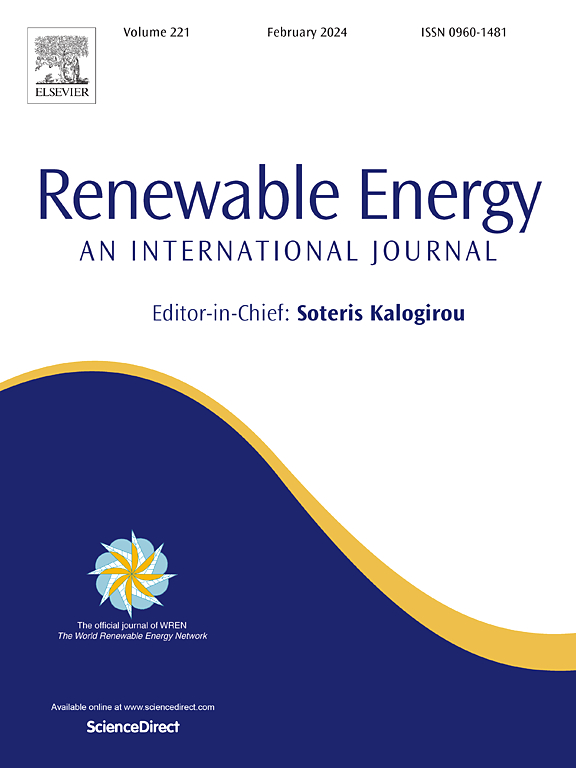Exergy-energy, and sustainability index assessment of oxy-acetylated enriched-TiO2-Scenedesmus obliquus biodiesel fuel blends in a diesel engine
IF 9
1区 工程技术
Q1 ENERGY & FUELS
引用次数: 0
Abstract
Biodiesel, prepared by transesterification of Scenedesmus-obliquus as a feedstock blended with acetylene-air at different flowrates is used to fuel a diesel engine. An Exergy-energy analysis compares baseline diesel at various engine design variables. The fuel samples were tested for sustainability, combustion efficiency, emissions, useful work energy, and engine performance, through exhaust gases in a Rainbow-186 Diesel engine at different loads. Data analysis provides optimal operating conditions for the efficient combustion of the fuel blends. Optimal performance was obtained at a compression ratio of 17.5 and injection pressure of 210 bar, with energy efficiency observed as 37.00 % for Scenedesmus-obliquus-biodiesel-TiO2 +200g/h-acetylene-air which is the most suitable fuel blends relative to the diesel fuel at 30.9 %. The biodiesel-acetylene-air addition reduces the NOx, CO2 and UHC emissions with an average of 17.23 %, 9.04 % and 12.77 % when compared with diesel fuel. While such reductions may demonstrate technological advancements, their real-world impact depends on operating conditions, which can vary significantly in practical applications. Under full load, the exergy efficiencies and sustainability index values of the blends are 6.83, and 1.57 % higher, compared to diesel at full load. The highest sustainability index for the fuel blends is 1.6 at 100 % engine load in Scenedesmus-obliquus-biodiesel-TiO2 +200 g/h acetylene-air fuel.

生物柴油的制备方法是以 Scenedesmus-obliquus 为原料,与乙炔-空气以不同的流速混合后进行酯交换反应,用于柴油发动机的燃料。能耗分析比较了不同发动机设计变量下的基准柴油。在不同负荷下,通过 Rainbow-186 柴油发动机中的废气,对燃料样本的可持续性、燃烧效率、排放量、有用功能和发动机性能进行了测试。数据分析为混合燃料的高效燃烧提供了最佳操作条件。在压缩比为 17.5 和喷射压力为 210 巴的条件下,生物柴油-二氧化钛 +200 克/小时乙炔-空气混合燃料获得了最佳性能,能量效率为 37.00%,与 30.9%的柴油相比,这是最适合的混合燃料。与柴油相比,生物柴油-乙炔-空气混合燃料平均减少了 17.23%、9.04% 和 12.77%的氮氧化物、二氧化碳和 UHC 排放。虽然这种减排效果可以证明技术的进步,但其实际影响取决于运行条件,而实际应用中的运行条件可能会有很大差异。在满负荷情况下,与柴油相比,混合燃料的放能效率和可持续性指数值分别高出 6.83% 和 1.57%。在 Scenedesmus-obliquus-biodiesel-TiO2 +200 g/h 乙炔-空气燃料中,当发动机负荷达到 100%时,混合燃料的最高可持续性指数为 1.6。
本文章由计算机程序翻译,如有差异,请以英文原文为准。
求助全文
约1分钟内获得全文
求助全文
来源期刊

Renewable Energy
工程技术-能源与燃料
CiteScore
18.40
自引率
9.20%
发文量
1955
审稿时长
6.6 months
期刊介绍:
Renewable Energy journal is dedicated to advancing knowledge and disseminating insights on various topics and technologies within renewable energy systems and components. Our mission is to support researchers, engineers, economists, manufacturers, NGOs, associations, and societies in staying updated on new developments in their respective fields and applying alternative energy solutions to current practices.
As an international, multidisciplinary journal in renewable energy engineering and research, we strive to be a premier peer-reviewed platform and a trusted source of original research and reviews in the field of renewable energy. Join us in our endeavor to drive innovation and progress in sustainable energy solutions.
 求助内容:
求助内容: 应助结果提醒方式:
应助结果提醒方式:


